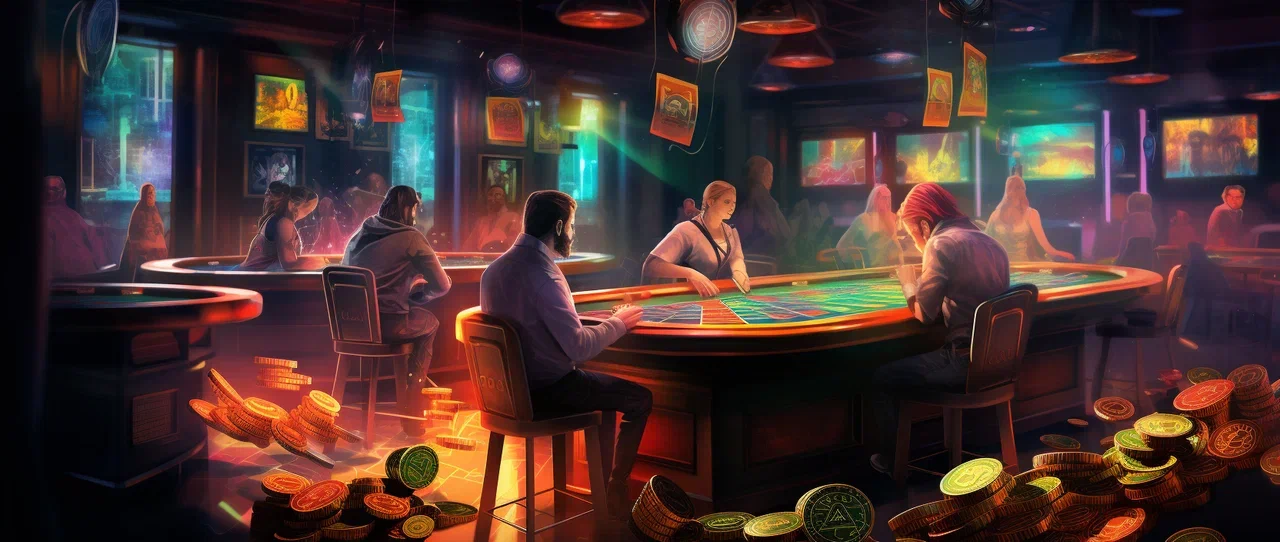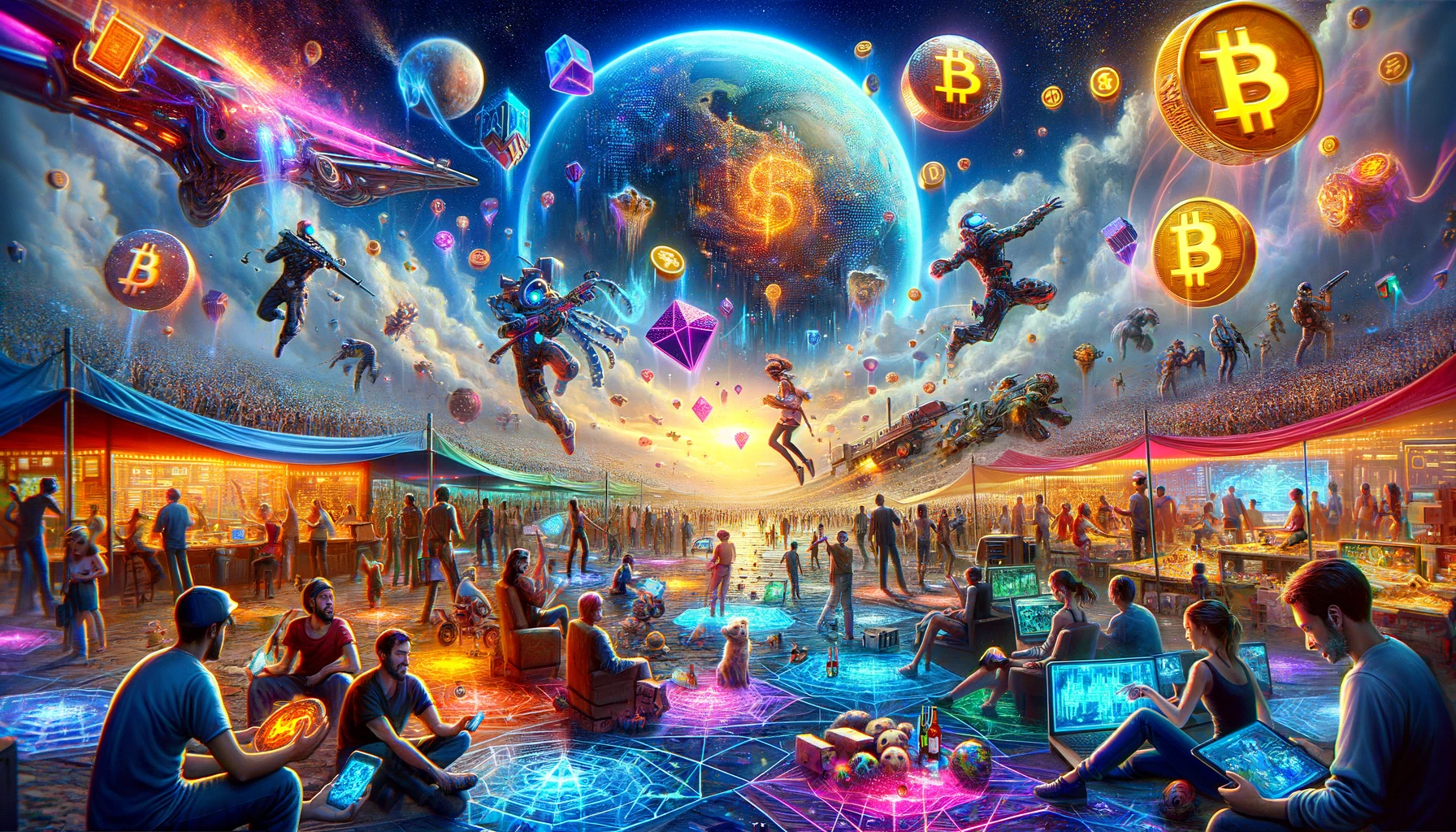NFTs are unique digital assets for collection on the blockchain, used in video games as characters, game items, and other exchange options.
In the world of blockchain games (Game-Fi), the use of NFTs has become a popular way to earn money: players can sell their game NFTs to other participants and collectors, as well as earn tokens through Play-to-Earn systems.
When conducting transactions with game NFTs, it's important to ensure wallet compatibility and be wary of fraud when transferring NFTs to marketplaces or other users. It is recommended to thoroughly study the rules of the specific NFT game and be aware of potential risks.
Most NFT games are developed on the Ethereum blockchain or Binance Smart Chain (BSC) platforms, where players can battle using collectible characters, as in CryptoBlades and Axie Infinity, or collect trading cards, as in Sorare.
Binance offers mystery NFT boxes that give owners access to digital assets of varying rarity. Some of these boxes are part of collections created in collaboration with NFT game developers.
- Introduction
- What are NFTs?
- Structure of NFT Games
- NFT Games with Play-to-Earn Model
- What are In-Game NFTs
- Profitability and Risks in NFT Games
- Security of Storing NFT Tokens

Introduction
The explosive popularity of CryptoKitties once spurred interest in creating new NFT games and the emergence of the Play-to-Earn earning model, where users can earn by progressing in the game. Currently, the Game-Fi sector merges the gaming industry and finance, offering players various ways to generate income. Now, player earnings are not limited exclusively to lucky finds or creating a unique collectible item worth thousands of dollars. Instead, participants are offered to explore a multitude of game mechanics in various genres, going beyond the simple collection of collectible creatures. Several examples of popular NFT games can be mentioned:
| Name | Blockchain | Type | Features |
|---|---|---|---|
| Axie Infinity | Ethereum | Collecting and Battling Creatures | Earning from selling SLP, Axie, and AXS. Trading on Binance. |
| Sorare | Ethereum | Fantasy Football | Trading collectible football player cards. Earning points for game achievements. |
| Gods Unchained | Ethereum | Card Game | Collecting decks for battles. Earning Flux to create NFT cards. |
| Binance NFT Collections | Binance Smart Chain and Ethereum | Marketplace with mystery boxes and collections | Mystery boxes with NFTs of varying rarity. Partnership with artists and games. |
The variety of NFT games is widely represented in the BSC and Ethereum blockchains. Some focus on classic game elements, while others predominantly emphasize the collection of non-fungible tokens.
What are NFTs?
A Non-Fungible Token (NFT) represents a unique digital object on the blockchain, acting as a cryptographic token that can symbolize everything from a gaming asset to a piece of crypto art or even a real-world object like real estate. NFTs offered a solution to the problem of creating a decentralized system for collecting and owning unique items in the digital world, where any content can be copied. Each NFT is unique and cannot be exchanged for another NFT on identical terms. For example, one bitcoin (BTC) can be exchanged for another bitcoin of absolutely equal value, but a similar exchange of NFTs is impossible due to the uniqueness of each token. Even if an NFT artwork is released in multiple copies, each token will differ by unique metadata, similar to numbered series of lithographs.
Structure of NFT Games
NFT games represent more than just storing crypto-collectibles in an electronic wallet. They integrate non-fungible tokens into the game rules, mechanisms, and user interactions. For example, your unique game character or avatar can be an NFT, as well as various digital objects found by you during gameplay. Players have the opportunity to trade or sell these tokens to other participants to make a profit, as well as earn tokens through the modern Play-to-Earn model.
To enable the exchange, creation, and use of NFTs in games, developers use smart contracts, which embed rules for working with these tokens.
As an example, the game CryptoKitties, where several key contracts form the basis of gameplay. One of the most famous contracts, geneScience, is responsible for generating new cats on a random basis. Developers initially kept the code of this mechanism secret, prompting players to create special tools for analyzing the probability of certain characteristics in cats, thereby giving them an advantage in breeding rare and valuable breeds.
NFT Games with Play-to-Earn Model
NFT games based on the Play-to-Earn model offer the possibility of earning money by spending time in gameplay. The more time a user spends in the game, the more they can earn tokens or even NFTs, which can then be used to create new game elements.
Earning income from game achievements is considered more predictable than randomly making a profit from rare NFTs. This model is especially attractive in countries with a low standard of living, providing players a chance to increase their income.
An example of a successful Play-to-Earn game is Axie Infinity. To start playing, you need to purchase at least three Axie creatures or receive them as part of a scholarship from another player. Forming a starting team, players can participate in tasks and challenges, earning Smooth Love Potion (SLP), an ERC-20 token, which can be exchanged on cryptocurrency exchanges.
SLP plays a key role in the Axie Infinity game economy, used for breeding new creatures. The game gained particular popularity in the Philippines, where it became a source of income for many users. By earning in Axie Infinity, players can receive from 200 to 1000 dollars a month, and in some cases more, depending on the market value of the tokens and the time spent in the game.

What are In-Game NFTs
In-game NFTs represent one of the methods of earning in the world of NFT games. Unlike fungible tokens like ERC-20 (such as SLP in Axie Infinity or SKILLS in CryptoBlades), players receive non-fungible tokens, which act as collectible game objects. This approach is a classic way of earning in NFT games, with the value of such collectible items determined by their design, uniqueness, or functional value.
An example of a game based on collecting in-game NFTs is CryptoKitties. It's important to realize that profitability in such games largely depends on the player's luck. To create a more balanced gaming experience, new NFT games often offer a combination of the Play-to-Earn mechanism and in-game NFTs.
Profitability and Risks in NFT Games
Earnings in NFT games vary depending on the game features and market relevance. Players can generate income by selling cryptocurrency or NFTs that are in demand among other participants. Income is realized through trading on marketplaces, exchanges, or through auctions, where the value of tokens is determined by their uniqueness or functionality within the game. These aspects make games attractive for speculative investments.
The risk of losing funds in NFT games indeed exists and depends on the specific conditions of the game, its mechanisms, and the value of the invested NFTs. Losses are not always related to fraud, as the value of NFTs is determined by speculative demand and supply from other market participants. It's important to approach investments in cryptocurrencies and NFT games with an understanding of potential risks and to invest only those funds whose loss you can afford.
Security of Storing NFT Tokens
Given the significant value of many non-fungible tokens, concerns about the security and preservation of NFTs during gameplay or blockchain transactions worry their owners. Whether acquired or earned in a game, it's important to ensure their protection, as there is a risk of losing these assets if not vigilant. To minimize this risk, certain recommendations should be followed.
NFTs can be lost in several ways:
- Transferring NFTs to a wallet that does not support the corresponding token format.
- Sending NFTs to individuals engaged in fraud.
- Granting access to your wallet to a malicious smart contract that can annex your NFTs.
- Loss of NFTs due to the specifics of game rules.
To avoid the first three situations, one must possess knowledge about the principles of NFT, blockchain technology, and common fraudulent schemes. Observing security rules when working with NFTs is as important as using PayPal or internet banking. Therefore, to prevent the loss of NFTs, it is important to adhere to the following security measures:
- Be sure not to transfer NFTs to fraudsters. Information on how to recognize potential fraudsters can be found in specialized guides.
- Determine which token formats and blockchains your wallet or platform supports. ERC-721 and ERC-1155 are standard protocols for NFTs on Ethereum, and BEP-721 and BEP-1155 for Binance Smart Chain. Always check addresses for correctness and do not make assumptions about their compatibility.
- Interact exclusively with smart contracts from verified projects. By giving a smart contract access to your wallet, you risk that a malicious contract can withdraw your assets.
- Carefully study the game rules. Some games allow trading between players or the use of consumable NFTs, such as items or potions. Familiarize yourself with the terms in advance to avoid surprises.
In NFT games, digital collectible objects define the interaction between players through NFTs. User interests may vary: some value the gaming functionality of NFTs, while for others, their rarity and collectible value are more important. Although many NFT games are oriented towards card battles, not every collector actively uses their decks in games. The Game-Fi financial industry has innovated the NFT economy, changing approaches to earning: now, income depends not only on luck and the ability to collect rare items but also on participation in gameplay.




